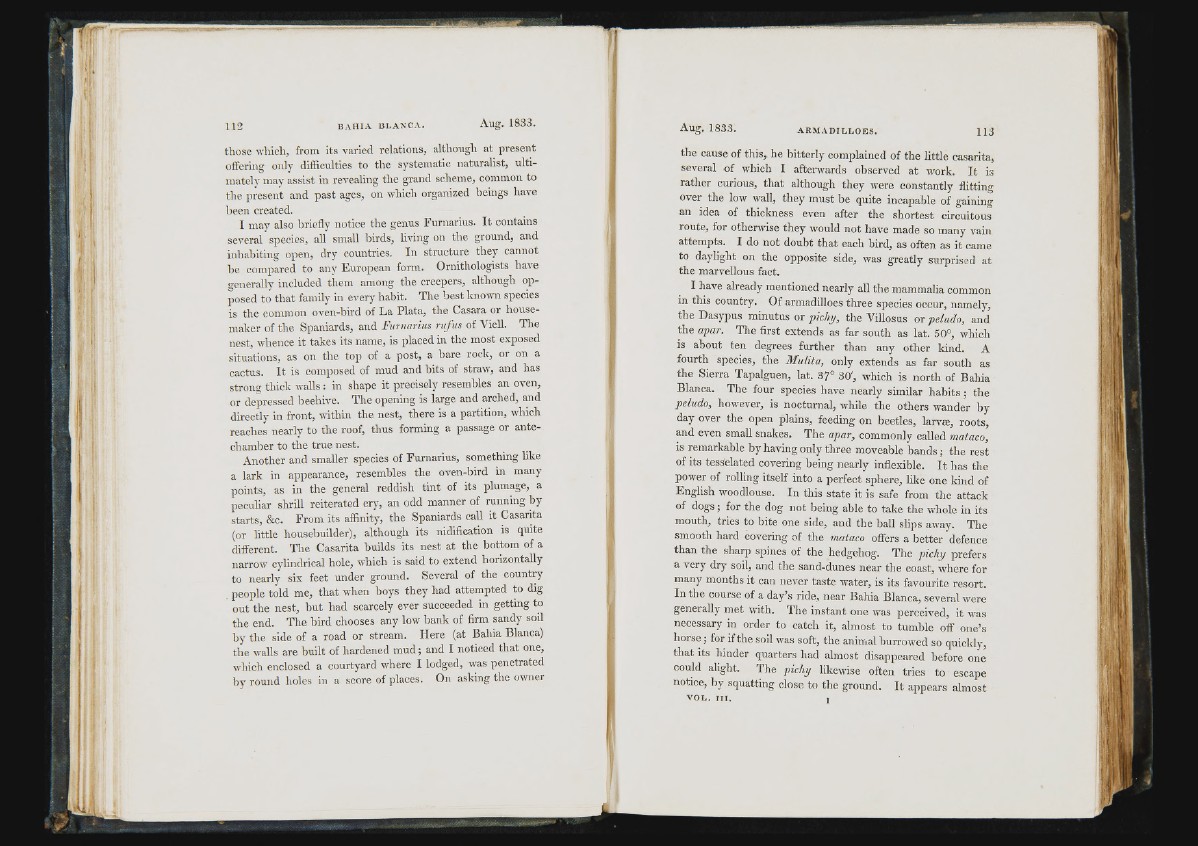
l ì
those which, from its varied relations, although at present
offering only difficulties to the systematic naturalist, ultimately
may assist in revealing the grand scheme, common to
the present and past ages, on which organized beings have
been created.
I may also briefly notice the genus Furnarius. It contains
several species, all small birds, living on the ground, and
inhabiting open, dry countries. In structure they cannot
be compared to any European form. Ornithologists have
generally included them among the creepers, although opposed
to that family in every habit. The best known species
is the common oven-bird of La Plata, the Casara or house-
maker of the Spaniards, and Furnarius rufus of Viell. The
nest, whence it takes its name, is placed in the most exposed
situations, as on the top of a post, a bare rock, or on a
cactus. It is composed of mud and bits of straw, and has
strong thick walls : in shape it precisely resembles an oven,
or depressed beehive. The opening is large and arched, and
directly in front, within the nest, there is a partition, which
reaches nearly to the roof, thus forming a passage or antechamber
to the true nest.
Another and smaller species of Furnarius, something like
a lark in appearance, resembles the oven-bird in many
points, as in the general reddish tint of its plumage, a
peculiar shrill reiterated cry, an odd manner of running by
starts, &c. From its affinity, the Spaniards call it Casarita
(or little housebuilder), although its nidification is quite
different. The Casarita builds its nest at the bottom of a
narrow cylindrical hole, which is said to extend horizontally
to nearly six feet under ground. Several of the country
people told me, that when boys they had attempted to dig
out the nest, but had scarcely ever succeeded in getting to
the end. The bird chooses any low bank of firm sandy soil
by the side of a road or stream. Here (at Bahia Blanca)
the walls are built of hardened mud; and I noticed that one,
which enclosed a courtyard where I lodged, was penetrated
by round holes in a score of places. On asking the owner
the cause of this, he bitterly complained of the little casarita,
several of which I afterwards observed at work. It is
rather curious, that although they were constantly flitting
over the low wall, they must be quite incapable of gaining
an idea of thickness even after the shortest circuitous
route, for otherwise they would not have made so many vain
attempts. I do not doubt that each bird, as often as it came
to daylight on the opposite side, was greatly surprised at
the marvellous fact.
I have already mentioned nearly all the mammalia common
in this country. Of armadilloes three species occur, namely,
the Dasypus minutus or pichy, the Villosus or peludo, and
the apar. The first extends as far south as lat. 50°, which
is about ten degrees further than any other kind. A
fourth species, the Mulita, only extends as far south as
the Sierra Tapalguen, lat. 37° 30', which is north of Bahia
Blanca. The four species have nearly similar habits ; the
peludo, however, is nocturnal, while the others wander by
day over the open plains, feeding on beetles, larvæ, roots,
and even small snakes. The apar, commonly called mataco,
is remarkable by having only three moveable bands; the rest
of its tesSelated covering being nearly inflexible. It has the
power of rolling itself into a perfect sphere, like one kind of
English woodlouse. In this state it is safe from the attack
of dogs ; for the dog not being able to take the whole in its
mouth, tries to bite one side, and the ball slips away. The
smooth hard covering of the mataco offers a better defence
than the sharp spines of the hedgehog. The pichy prefers
a very dry soil, and the sand-dunes near the coast, where for
many months it can never taste water, is its favourite resort.
In the course of a day’s ride, near Bahia Blanca, several were
generally met with. The instant one was perceived, it was
necessary in order to catch it, almost to tumble off one’s
horse ; for if the soil was soft, the animal burrowed so quickly,
that its hinder quarters had almost disappeared liefore one
could ahght. The pichy likewise often tries to escape
notice, by squatting close to the ground. It appears almost
V O L . I I I . I
;|1
I’ 1
I
ri-íT
.ill
i ! ‘i
| ‘| u i !